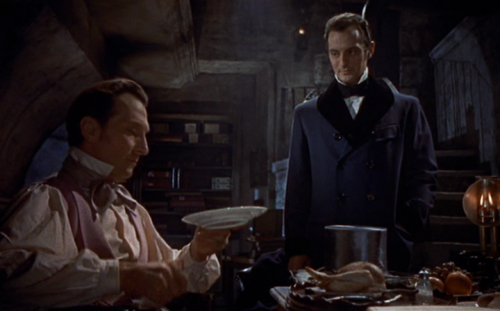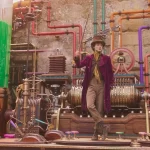Hammer-Rama: The Revenge of Frankenstein, by Alexander Miller
Needless to say, The Curse of Frankenstein shook up the world of horror and put Hammer on the map. By this time, Universal’s classic monsters descended into self-parody with Abbott and Costello Meet Frankenstein along comes this colorful and lurid reimagining of Shelley’s novel with gore and sex accentuated by a straight-faced execution of material that had been the subject of ridicule. American audiences and studios alike were enthusiastic in 1957, and Hammer went from quota quickies to international commodities. By 1958, Hammer had revised not one but two wildly successful classic monster movies with The Curse of Frankenstein and Horror Of Dracula. Naturally, more monsters would reach the silver screen but Hammer decided to revisit the Frankenstein series after going to Transylvania.
Jimmy Sangster began the script for The Revenge of Frankenstein (originally titled Blood of Frankenstein) immediately after the shooting of The Horror of Dracula; so close in proximity, the two films are mistaken as simultaneous productions.
Unfettered by the first film’s finale where the titular character is beheaded and the monster destroyed, Sangster’s jocular response to the “hows” of The Revenge of Frankenstein was simply “we just sew his head back on.” After all, he is a surgeon. Cited by some as superior to the film before it The Revenge of Frankenstein is an expertly crafted horror film with terrific acting that only has one damaging flaw; it’s not all that scary. Despite a small shortcoming, this strong follow-up to the original is a standout title in Hammer’s Frankenstein series that, as far as horror franchises are concerned, doesn’t suffer from any serious weak entries.
In the tradition of sequels, The Revenge of Frankenstein picks up immediately after the first film, showing us how the Baron escaped the guillotine and sets himself up with an independent practice that caters to both high society as well as poor vagrants under the clever pseudonym “Dr. Stein.” Some revere the doctor for being what looks like a humanitarian; caring for those maligned by society but it’s just a front to harvest their body parts. Once the self-styled Dr. Stein is recognized by Hans Kleve, a member of the medical council who coerces his way to assist Stein, however, it’s a mutual admiration since Hans is a great admirer of Dr. Stein’s work. This time around Frankenstein’s creation is much cleaner than his last experiment; instead of a “monster”, this creation is merely a vessel for his hunchback assistant Karl (not Igor) who volunteers his brain to be transplanted into the man-made body.
Hammer knew they had a powerful actor in Cushing and decided to shift the focus of their Frankenstein films to the Baron instead of his monsters, which is evident in this movie as the “monster” is merely a man who only turns deranged by unfortunate circumstances. Cushing’s emphatic, brainy and astute interpretation is aided in part by Jimmy Sangster, a script machine who’s central in Hammer’s golden era of movies.
On the surface it might seem like Hammer’s reputation is just horror movies but the cultural resonance of these films is astounding as well as impossible to ignore.
Anthony Hinds was taking cues from the cultural rumblings that lead to kitchen sink realism, with directors Lindsay Anderson and Tony Richardson germinating after Look Back in Anger was a sensation in the Royal Court Theater. Played against the milquetoast melancholia of James Dean and Montgomery Clift, producer Anthony Hinds suggested that they should “make Frankenstein a shit.” They did so by making him a brainy and incorrigible sociopath who is rebellious and plays by his own rules; Frankenstein is a rebel with a cause. While working on his clandestine operation, Dr. Stein is also under the heavy scrutiny of an all too suspicious medical counsel who objects to his autonomous practice. Of course, his refusal has a lot to do with the fact that he’s mutilating people for his experiments, but he’s clearly above them in skill set and intellect. The pleasure we derive from this character is due to Cushing’s dedicated performance, unlike Lee, who instantly feared typecasting after Hammer’s first Dracula film, however, Cushing was never begrudging but enthusiastic, and his shrewd and sinister performances always suited the material, Cushing was a pro.
Despite missing the syllabic score of James Bernard, Leonardo Salzedo proves to be up to the task, supplying musical arrangements evocative of traditional horror movie stylings but with few scares to speak of. It’s more atmospheric accentuation we get from Salzedo. Jak Asher’s illuminating cinematography compliments the precise direction of Terence Fisher, who was at the top of his game. The sickly greens and reds that populated The Curse of Frankenstein is replaced by aqua shaded blues, and grays, with of course the occasional burst of red. While the “gore” (quotations once again because it’s the late fifties) is less prevalent than its predecessor, some operating scenes provide obligatory bloodshed. Instead of fashioning one from gelatin or latex, they used a real sheep’s brain for the transplant scene and, according to co-star Francis Matthews (who played Hans), someone forgot to refrigerate it and by shooting “the smell was appalling, all the technicians were fainting.” But, of course, the show went on. Sets by Bernard Robinson deserve accolades for endlessly transforming the Bray Studio manor; sometimes it’s Count Dracula’s castle, others it’s Frankenstein’s laboratory. The countless ways in which they sculpted this one level manor house is masterful and, for fans, it’s fun to spot a familiar room, staircase, or walkway throughout the many Hammer movies shot there.
Usually, with older films with a devoted cult following, they’re sustained by critical appraisal but not box office returns. In Hammer’s case, these films made a killing but critics were merciless in their lambasting of the pictures. Their Frankenstein movies were referred to as “degrading & depressing” but this skillfully made film is cited by many as one of their best, and rightfully so. Cushing is fantastic, but the supporting players contribute substantially to the overall success of The Revenge of Frankenstein.
Francis Matthews is a formidable assistant, more sinister than his predecessor Robert Urquhart; after all, evil doings seem to flow smoother with assistance. Michael Gwynn is no Christopher Lee, but that’s not the idea because Hammer chose to make this film about the maker, not the monster, and Gwynn turns out to be one of the most sympathetic of Frankenstein’s creations. While this movie might not be “scary” in the traditional sense, it’s an immersive examination of Frankenstein’s legacy following his original experiment.





























